On this page:
- Annex A — Global Patent Prosecution Highway System Participating Offices
- Annex B — Global PPH Pilot Criteria
- Annex C — Global PPH Principles
- Annex D — Claim Correspondence
- Annex E — Available Dossier Access Systems
- Annex F — Corresponding claims
- Annex G — Text for open letter
- Annex H — Examples of Canadian patent applications that may request accelerated examination under the GPPH System at CIPO
-
In order to further improve the Patent Prosecution Highway (PPH) system by enhancing its attractiveness to applicants and increasing associated efficiencies for intellectual property offices, the offices listed in the document titled "Global Patent Prosecution Highway System Participating Offices"
(Annex A) have decided to participate in a Global PPH (GPPH) pilot arrangement according to the criteria set out in the document titled Global PPH Pilot Criteria (Annex B) and with reference to the Global PPH Principles (Annex C). -
The GPPH pilot will commence on Monday 6th January 2014.
-
The participating offices will periodically evaluate and exchange information on the status and effectiveness of the GPPH pilot, and may consider modifying the GPPH pilot on the basis of the evaluation results.
-
New offices wishing to join the GPPH pilot can apply to join at one of two points in every year – on the 6th January or on the 6th July. In order to be eligible to join, an office must declare its interest in joining the GPPH to the Secretariat no later than two months before these dates in order to allow existing members time to prepare for the expansion of the GPPH network. Requests to join the GPPH should be accompanied by the standard letter (Annex G), provided on the Office's headed paper and signed by the Head of Office. The Secretariat will then circulate a copy of this letter to all other existing GPPH offices.
-
Offices wishing to participate in the pilot will, using the required format, provide the GPPH Secretariat with requested information including an outline of their patent application processes, quality assurance processes, and their examination practices, for consolidation into a comparative guide to practices at all participating offices.
-
This framework may be amended at any time with the consent of all the participating offices involved.
-
Offices participating in the pilot reserve the right to limit or end their participation in the GPPH pilot at any stage by giving written notice not less than one month prior to the date of withdrawal.
Annex A — Global Patent Prosecution Highway System Participating Offices
- IP Australia (IP Australia)
- Austrian Patent Office (APO)
- Canadian Intellectual Property Office (CIPO)
- National Institute of Industrial Property of Chile (INAPI)
- Superintendency of Industry and Commerce of the Republic of Colombia (SIC)
- Danish Patent and Trademark Office (DKPTO)
- Estonian Patent Office (EPA)
- Finnish Patent and Registration Office (PRH)
- German Patent and Trade Mark Office (DPMA)
- Hungarian Intellectual Property Office (HIPO)
- Icelandic Patent Office (IPO)
- Israel Patent Office (ILPO)
- Japan Patent Office (JPO)
- Korean Intellectual Property Office (KIPO)
- Intellectual Property Office of New Zealand (IPONZ)
- Nordic Patent Institute (NPI)
- Norwegian Industrial Property Office (NIPO)
- National Institute for the Defense of Competition and Protection of Intellectual Property of Peru (INDECOPI)
- Patent Office of the Republic of Poland (PPO)
- Portuguese Institute of Industrial Property (INPI)
- Russian Federal Service for Intellectual Property (Rospatent)
- Intellectual Property Office of Singapore (IPOS)
- Spanish Patent and Trademark Office (SPTO)
- Swedish Patent and Registration Office (PRV)
- United Kingdom Intellectual Property Office (UKIPO)
- United States Patent and Trademark Office (USPTO)
- Visegrad Patent Institute (VPI)
Annex B — Global PPH Pilot Criteria
1 Introduction
- 1.1 - This document provides the criteria upon which the Global Patent Prosecution Highway (GPPH) pilot is to operate.
- 1.2 - Under the GPPH pilot, a request for accelerated processing can be made at any participating office based on work products, including PCT work products, from any one of the other participating offices providing the following eligibility criteria are met.
- 1.3 - Participating offices may, if they wish, develop office-specific guidelines, e.g. to reflect their respective legal terminology and processes, and can apply additional flexibility beyond these requirements as they see fit. However, these criteria set out a standard to be adhered to by offices participating in the GPPH pilot so as to provide a uniform system for applicants, i.e. if the GPPH pilot specific requirements below are met, an application will qualify for PPH treatment.
- 1.4 - Where two participating offices have a pre-existing bi-lateral PPH arrangement, the guidelines of the Global PPH pilot will take precedence over those of the existing bi-lateral arrangement for the duration of the pilot.
2 Eligibility Requirements
- 2.1 –Offices will provide accelerated processing under the GPPH pilot for applications where the following requirements have been met:
- The applications before the Office of Earlier Examination (OEE) and the Office of Later Examination (OLE) have the same earliest date (which may be the priority date or the filing date).
- – At CIPO this may be the priority date or the filing date
- – For CIPO, where the USPTO is the OEE, and a national application is being used as the basis for the PPH request, the term "national application" refers to either: a provisional patent application, a non-provisional utility patent application, a continuation patent application, a continuation in part patent application, or a divisional patent application. Where the USPTO national application claims internal priority or is a continuation-in-part of more than one application, the earliest date of the USPTO national application is the earliest date of the related U.S. application(s).
- 2) The OEE has found at least one claim to be allowable. The indication that a claim is allowable will be provided as an explicit statement in any substantive work product from the OEE. The claim(s) determined as novel, inventive and industrially applicable in the PCT work products has/have the meaning of allowable in this document.
– See Annex F. - 3) All claims presented for examination under the GPPH pilot must sufficiently correspond to one or more of the claims found allowable by the OEE.
– See Annex D. - 4) The OLE has not begun substantive examination of the application. Substantive examination is considered to have begun when CIPO issues a first office action, i.e., an examination report or a notice of allowance. However, OLE's may still choose to allow GPPH requests filed after examination of the OLE application has begun depending on the particular circumstances and needs of the OLE and its stakeholders.
- 5) A request for substantive examination must have been filed at the OLE, either at the time of the GPPH request or previously.
- The applications before the Office of Earlier Examination (OEE) and the Office of Later Examination (OLE) have the same earliest date (which may be the priority date or the filing date).
- 2.2 – Participating Offices may require that the OLE application is open to the public.
– For Applicants making a request to CIPO, the CIPO application must be open to public inspection. - 2.3 – Participating Offices may require the applicant to pay a fee for GPPH acceleration due to their respective legal requirements for accelerated processing.
– Currently, there is no fee for applicants making a request to CIPO. - 2.4 – For an OEE application to be valid as the basis of a GPPH pilot request it must have been substantively examined, including consideration of novelty and inventive step, by an OEE participating in the GPPH pilot.
3 Supporting documentation required for GPPH request
- 3.1 – Participating offices will require the following documentation to support a request for acceleration under the GPPH pilot:
- 1) A completed GPPH request form;
- 2) A copy of the work product(s) which are relevant to the allowability of the claims of the corresponding OEE application, if not available via Dossier Access Systems; and
- 3) A copy of the claims found to be allowable by the OEE, if not available via Dossier Access Systems.
- 3.2 – Participating Offices may also require the applicant to provide the following documentation:
- 1) Copies of citations raised against the OEE application which are not available to the OLE via their regular databases or search files;
– For CIPO: See Annex E. - 2) Translations of any of the documents listed in points 3.1 2) or 3) (see point 3.3 below); and
– For CIPO, translations are required if the required documents and/or claims are not available in English or French. - 3) A claim correspondence table that shows the relationship between the claims of the OLE application and those of the OEE application that were considered allowable.
– For applicants making requests to CIPO, a claim correspondence table will be required.
- 1) Copies of citations raised against the OEE application which are not available to the OLE via their regular databases or search files;
- 3.3 – Participating offices will use Dossier Access Systems and machine translations to access and assess supporting documentation to the maximum extent possible. If the participating office has difficulty in obtaining documents listed in points 3.1 2) or 3) and translations thereof, the applicant may be asked to submit them. When machine translations are determined by the OLE to be of insufficient quality, then the applicant may also be asked to provide manual translation (see Annex E for available Dossier Access Systems).
4 Consideration of a GPPH request
4.1 – Requests for accelerated examination under the GPPH will be considered promptly by the OLE. Where a request for accelerated examination under the GPPH pilot is found to be deficient, the OLE will inform the applicant of the deficiencies and provide the applicant with at least one opportunity to correct the application within a reasonable period of time.
5 Miscellaneous Provisions
5.1 – Participating Offices will share basic statistical information and may conduct studies as appropriate, and as resources allow, in order to monitor usage and improve the quality of the system as a whole.
Annex C — Global PPH Principles
As a result of the success of the PPH Program, the maintenance of the many individual bilateral agreements between countries has become challenging. With that in mind, both applicants and participating offices would benefit from a single set of principles that form a world-wide PPH system. In addition, a common framework provides a baseline to which new PPH offices can subscribe without varying from the guidelines established by long-standing PPH partners. The following principles set the foundation for a global PPH system:
-
Consistent with the "MOTTAINAI" concept, PPH eligibility will be based on work available from any participating office, regardless of OFF/OSF status, so long as the applications share the same effective date (priority or filing) and the disclosures support the claimed subject matter.
-
Participating offices will accept any substantive search and examination product that explicitly indicates the patentability of claims(i.e., those including a written opinion if other than an initial notice to grant) done by another participating office under any filing scenario (e.g. as a National Office under the Paris Convention or as an ISA/IPEA office under the PCT).
-
Claim correspondence will be interpreted and applied by participating offices as per the formulation agreed to in October 2012.
-
Participating offices may require copies of prior office actions and/or decisional notices from the OEE and copies of any prior art cited that it cannot otherwise obtain, and should utilize dossier access systems and its internal search databases, respectively, for such purposes to the maximum extent practicable.
-
Participating offices may require a copy of the allowed claims in the earlier office and/or a chart illustrating correspondence.
-
Participating offices will accept machine translations of office actions, decisional notices, or allowed claims (as locally required) to the maximum extent practicable, but may require manual translations upon request from the examiner where necessary, e.g., if the quality of the machine translation is deemed of insufficient quality to assess the acceptability of the PPH request.
-
Participating offices will allow at least one opportunity to correct a defect in the PPH request before finally refusing a PPH request.
-
Participating offices may or may not accelerate applications for which PPH is requested after initiation of prosecution before the examiner, depending upon the circumstances and needs of each office and its stakeholder community.
-
Participating offices will share basic statistical information and may conduct studies as appropriate — and resources allow — in order to monitor usage and improve the quality of the system as a whole by providing mutual feedback among them as to any gaps identified.
-
Finally, participating offices reserve the right to limit participation in cases where incoming PPH requests exceed resources.
Annex D — Claim Correspondence
All claims on file, as originally filed or as amended, for examination under the PPH must sufficiently correspond to one or more of those claims indicated as allowable in the OEE. Claims are considered to "sufficiently correspond" where, accounting for differences due to translations and claim format, the claims in the OLE are of the same or similar scope as the claims in the OEE, or the claims in the OLE are narrower in scope than the claims in the OEE.
In this regard, a claim that is narrower in scope occurs when an OEE claim is amended to be further limited by an additional feature that is supported in the specification (description and/or claims).
A claim in the OLE which introduces a new/different category of claims to those claims indicated as allowable in the OEE is not considered to sufficiently correspond. For example, where the OEE claims only contain claims to a process of manufacturing a product, then the claims in the OLE are not considered to sufficiently correspond if the OLE claims introduce product claims that are dependent on the corresponding process claims.
(In practice, however, a certain degree of flexibility regarding 'sufficiently correspond' may be provided at the discretion of the OLE.)
Annex E — Available Dossier Access Systems
| Office | Dossier Access System |
|---|---|
| IP Australia | AusPat |
| National Institute of Industrial Property of Chile (INAPI) | https://ion.inapi.cl/Patente/ConsultaAvanzadaPatentes.aspx |
| CIPO | Canadian Patents Database |
| SIC | la Base de datos de patentes de invención via Búsqueda de solicitudes de Patente/Modelo de Utilidad/PCT/Esquemas de Trazado |
| DKPTO | PVS online |
| EPA | PATENDIAMET |
| PRH | PatInfo |
| DPMA | DPMAregister |
| HIPO | E-DOSSIER |
| ILPO | Israel Patent Database (Hebrew/English only) |
| JPO | AIPN |
| KIPO | K-PION |
| IPONZ | New Zealand Patent Register via Patent Search |
| NIPO | Advanced search Patent |
| PPO | E-Search Engine of the Patent Office of the Republic of Poland |
| IPOS | Patents Open Dossier |
| PRV | Swedish Patent Database |
| UKIPO | IPSUM |
| USPTO | Patent Center |
| WIPO | Patentscope |
| WIPO | WIPO CASE |
Annex F — Corresponding claims
Corresponding claims are considered to be allowable as indicated in the following work products:
| OEE | Work Products |
|---|---|
| IP Australia |
Published Accepted or Granted Standard Patent and/or Office Action entitled:
For PCT-PPH requests: WO-ISA, WO-IPEA, IPRP. |
| Austrian Patent Office (APO) |
Granted Patent Publication and/or Office Action entitled:
For PCT-PPH requests: WO-ISA, WO-IPEA or IPRP. |
| National Institute of Industrial Property of Chile (INAPI) |
|
| Canadian Intellectual Property Office (CIPO) |
(CIPO) Granted Patent Publication and/or Office Action entitled:
For PCT-PPH requests: WO-ISA, WO-IPEA or IPRP. |
| Superintendency of Industry and Commerce of the Republic of Colombia (SIC) |
|
| Danish Patent and Trademark Office (DKPTO) |
Granted Patent Publication and/or Office Action entitled:
|
| Estonian Patent Office |
Granted Patent Publication "Patendikirja" and/or Office action entitled:
|
| Finnish Patent and Registration Office (PRH) |
Granted Patent Publication and/or Office Action entitled:
For PCT-PPH requests: WO-ISA, WO-IPEA or IPRP. |
| German Patent and Trade Mark Office (DPMA) |
Granted Patent Publication, DPMA Extended Search Report Opinion and/or Office action entitled:
Please note that if claims are not deemed patentable in the "Pruefungsbescheide" or are amended afterwards, the "Erteilungsbeschluss" or the granted patent have to be provided. |
| Hungarian Intellectual Property Office (HIPO) |
Granted Patent Publication and/or Office Action entitled:
|
| Icelandic Patent Office (IPO) |
Granted Patent Publication and/or Office Action entitled:
|
| Israel Patent Office (ILPO) |
Granted Patent Publication and/or Office Action entitled:
For PCT-PPH requests: WO-ISA, WO-IPEA or IPRP. |
| Japan Patent Office (JPO) |
Granted Patent Publication and/or Office Action entitled:
For PCT-PPH requests: WO-ISA, WO-IPEA or IPRP. |
| Korean Intellectual Property Office (KIPO) |
Granted Patent Publication and/or Office Action entitled:
For PCT-PPH requests: WO-ISA, WO-IPEA or IPRP. |
| Intellectual Property Office of New Zealand (IPONZ) | An Accepted Application or Granted Patent and/or in an office action of a published application. An IPONZ office action includes an "Examination Report", "Notice of Acceptance" and a "Notice of Grant" |
| Nordic Patent Institute (NPI) |
For PCT-PPH requests: WO-ISA, WO-IPEA or IPRP. |
| Norwegian Industrial Property Office (NIPO) |
Granted Patent Publication and/or Office Action entitled:
|
| National Institute for the Defense of Competition and Protection of Intellectual Property of Peru (INDECOPI) |
|
| Patent Office of the Republic of Poland (PPO) |
Granted Patent Publication and/or in the following Office Actions:
|
| Portuguese Institute of Industrial Property (INPI) |
Granted Patent Publication and/or Office Action entitled:
|
| Intellectual Property Office of Singapore (IPOS) |
Granted Patent Publication and/or Office Action entitled:
For PCT-PPH requests: WO-ISA, WO-IPEA or IPRP. |
| Spanish Patent and Trademark Office (SPTO) |
Granted Patent Publication and/or Office Action entitled:
For PCT-PPH requests: WO-ISA, WO-IPEA or IPRP. |
| Swedish Patent and Registration Office (PRV) |
Granted Patent Publication and/or Office Action entitled:
For PCT-PPH requests: WO-ISA, WO-IPEA or IPRP. |
| United Kingdom Intellectual Property Office (UKIPO) |
Granted Patent Publication and/or Notification of Grant letter. |
| United States Patent and Trademark Office (USPTO) |
Letters Patent and/or an Office action entitled:
For PCT-PPH requests: WO-ISA, WO-IPEA or IPRP. |
| Visegrad Patent Institute (VPI) |
For PCT-PPH requests: WO-ISA, WO-IPEA or IPRP. |
Annex G — Text for open letter
Dear Sirs,
In order to further improve the Patent Prosecution Highway (PPH) system by enhancing its attractiveness to applicants and increasing associated efficiencies for intellectual property offices, the [***insert office name here***] intends to participate in a Global PPH (GPPH) pilot arrangement according to the attached guidelines and criteria (which are also available from the website https://www.jpo.go.jp/e/toppage/pph-portal/index.html).
Yours faithfully,
On behalf of [***insert office name here***]
Annex H: Examples of Canadian patent applications that may request accelerated examination under the GPPH System at CIPO
In the examples below Office of Earlier Examination (OEE) refers to the partner Office of the GPPH, while the Office of Later Examination (OLE) refers to CIPO as the office before which participation in the GPPH pilot programme is being requested.
Example A
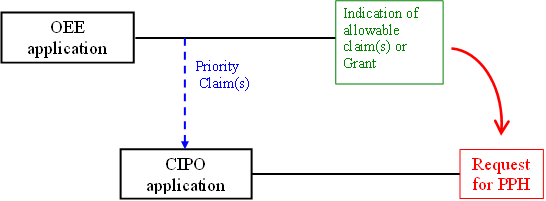
A nationally filed application at CIPO validly claims priority under the Paris Convention from an Office of Earlier Examination (OEE) national application which has an indication of allowable subject matter or has granted as a patent. A PPH request is made for the nationally filed application at CIPO, based on the indication of allowable subject matter in the OEE or the OEE granted patent.
Example B
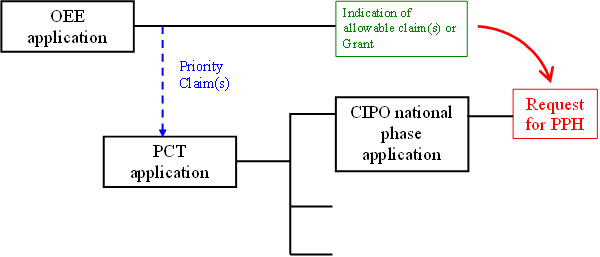
A PCT international application is filed and enters national phase at CIPO. The PCT application validly claims priority from an OEE national application which has an indication of allowable subject matter or has granted as a patent. A PPH request is made for the national phase application at CIPO, based on the indication of allowable subject matter in the OEE or the OEE granted patent.
Example C

A nationally filed application at CIPO validly claims priority under the Paris Convention from two earlier applications: an OEE national application and a national application filed at any office. The OEE national application has an indication of allowable subject matter or has granted as a patent. A PPH request is made for the nationally filed application at CIPO, based on the indication of allowable subject matter in the OEE or the OEE granted patent.
Example D

A nationally filed application at CIPO validly claims priority under the Paris Convention from an OEE national application which has an indication of allowable subject matter or has granted as a patent. A PPH request is made for a divisional of the nationally filed application at CIPO, based on the indication of allowable subject matter in the OEE or the OEE granted patent.
Example E
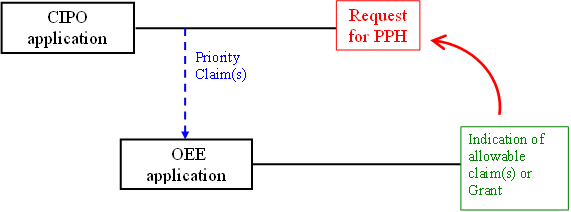
A nationally filed application at the OEE validly claims priority under the Paris Convention from a CIPO national application. The OEE national application has an indication of allowable subject matter or has granted as a patent. A PPH request is made for the nationally filed application at CIPO, based on the indication of allowable subject matter in the OEE or the OEE granted patent.
Example F

A PCT international application is filed and enters national phase at the OEE. The OEE national phase application has an indication of allowable subject matter or has granted as a patent. The PCT application validly claims priority from a CIPO national application. A PPH request is made for the national application at CIPO, based on the indication of allowable subject matter in the OEE or the OEE granted patent.
Example G
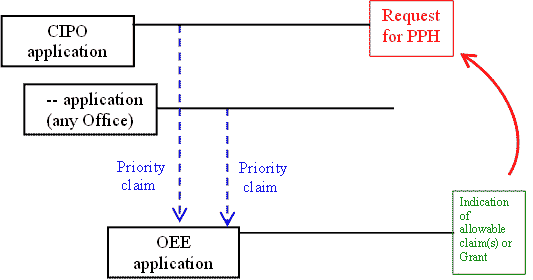
A nationally filed application at the OEE validly claims priority under the Paris Convention from two earlier applications: a CIPO national application and a national application filed at any office. The OEE national application has an indication of allowable subject matter or has granted as a patent. A PPH request is made for the nationally filed application at CIPO, based on the indication of allowable subject matter in the OEE or the OEE granted patent.
Example H
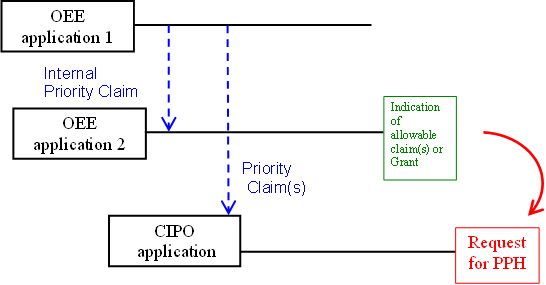
A nationally filed application at CIPO validly claims priority under the Paris Convention from OEE national application 1. OEE national application 2 validly claims internal priority from OEE national application 1 and has an indication of allowable subject matter or has granted as a patent. A PPH request is made for the nationally filed application at CIPO, based on the indication of allowable subject matter in the OEE or the OEE granted patent.
Example I
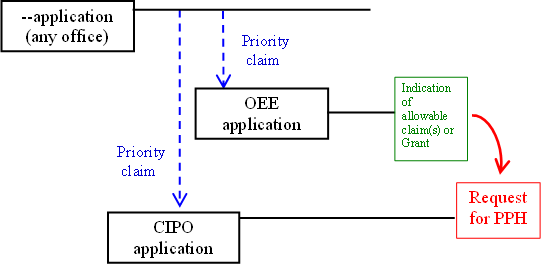
A nationally filed application at CIPO validly claims priority under the Paris Convention from an earlier national application filed at any office. An OEE national application claims priority to the same earlier application and has an indication of allowable subject matter or has granted as a patent. A PPH request is made for the nationally filed application at CIPO, based on the indication of allowable subject matter in the OEE or the OEE granted patent.
Example J
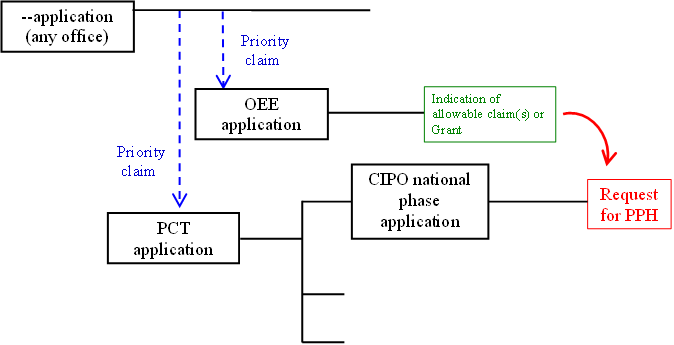
A PCT international application is filed and enters national phase at CIPO. The PCT application validly claims priority from a national application filed at any office. An OEE national application claims priority to the same earlier application and has an indication of allowable subject matter or has granted as a patent. A PPH request is made for the national phase application at CIPO, based on the indication of allowable subject matter in the OEE or the OEE granted patent.
Example K

A PCT international application is filed and enters national phase at CIPO and the OEE. The PCT application validly claims priority from a national application filed at any office. The OEE national phase application receives an indication of allowable subject matter or is granted as a patent. A PPH request is made for the CIPO national phase application, based on the indication of allowable subject matter in the OEE or the OEE granted patent.
Example L
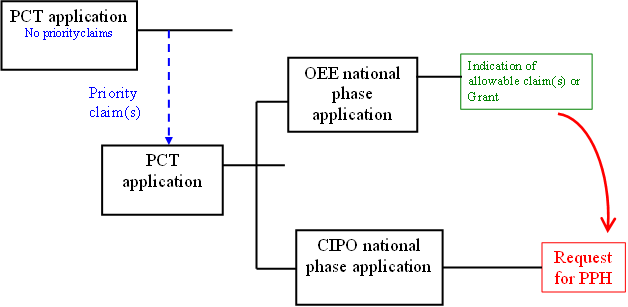
A PCT international application is filed and enters national phase at CIPO and the OEE. The national phase OEE application receives an indication of allowable subject matter or is granted as a patent. The PCT application validly claims priority from an earlier PCT application which has no priority claims. A PPH request is made for the national phase application at CIPO, based on the indication of allowable subject matter in the OEE or the OEE granted patent.
Example M

A PCT international application is filed and enters national phase at CIPO and the OEE. The PCT application has no priority claims. The OEE national phase application receives an indication of allowable subject matter or is granted as a patent. A PPH request is made for the CIPO national phase application, based on the indication of allowable subject matter in the OEE or the OEE granted patent.
Example N
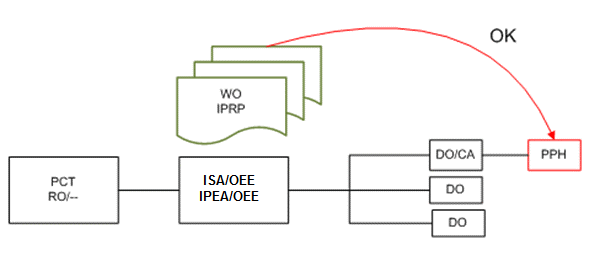
A PCT international application is filed and enters national phase at CIPO. The OEE was the ISA or IPEA for the PCT application and provided an indication of allowable subject matter. A PPH request is made for the national phase application at CIPO, based on the indication of allowable subject matter in the PCT international application.
Example N'
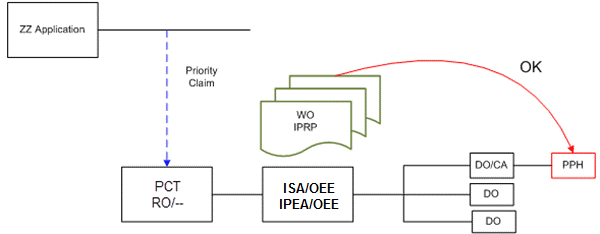
A PCT international application is filed and enters national phase at CIPO. The PCT application validly claims priority from a national application filed at any office. The OEE was the ISA or IPEA for the PCT application and provided an indication of allowable subject matter. A PPH request is made for the national phase application at CIPO, based on the indication of allowable subject matter in the PCT international application.
Example N"

A PCT international application is filed and enters national phase at CIPO. The PCT application validly claims priority from a PCT international application filed at any office. The OEE was the ISA or IPEA for the PCT application and provided an indication of allowable subject matter. A PPH request is made for the national phase application at CIPO, based on the indication of allowable subject matter in the PCT international application.
Example O
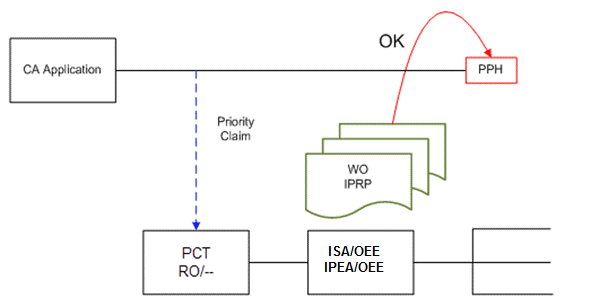
A PCT application validly claims priority from a CIPO national application. The OEE was the ISA or IPEA for the PCT application and provided an indication of allowable subject matter. A PPH request is made for the CIPO national application, based on the indication of allowable subject matter in the PCT international application.
Example P

A PCT international application is filed at any office and enters national phase at CIPO. The PCT application validly claims priority from a previously filed PCT international application filed at any office. The OEE was the ISA or IPEA for the previously filed PCT application filed at any office and provided an indication of allowable subject matter. A PPH request is made for the national phase application at CIPO, based on the indication of allowable subject matter in the PCT international application.
Example Q
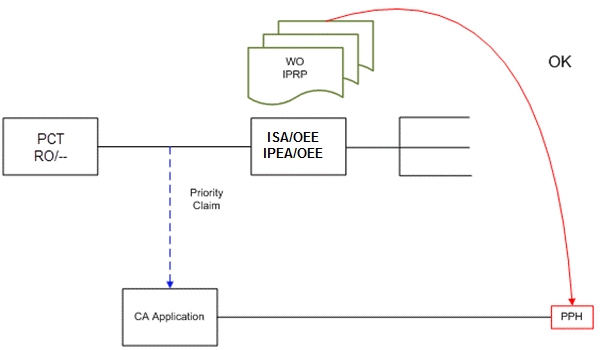
A nationally filed application at CIPO validly claims priority under the Paris Convention from a PCT international application filed at any office. The OEE was the ISA or IPEA for the PCT application and provided an indication of allowable subject matter. A PPH request is made for the CIPO national application, based on the indication of allowable subject matter in the PCT international application.
Example R
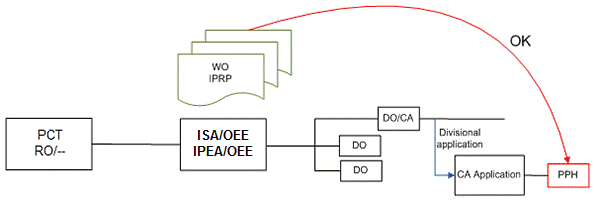
The application is a divisional application of an application which satisfies the scenario in Examples N, N' and N". A PPH request is made for the divisional application, based on the indication of allowable subject matter in the PCT international application.
Example S
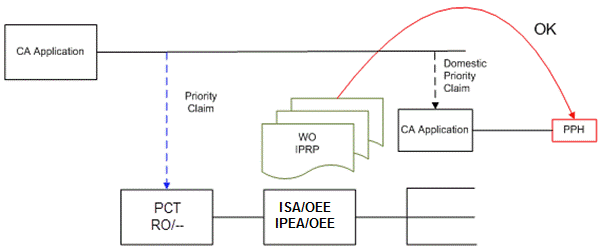
The application is an application claiming internal priority from an application which satisfies the scenario in Example O. A PPH request is made for the application claiming internal priority, based on the indication of allowable subject matter in the PCT international application.
